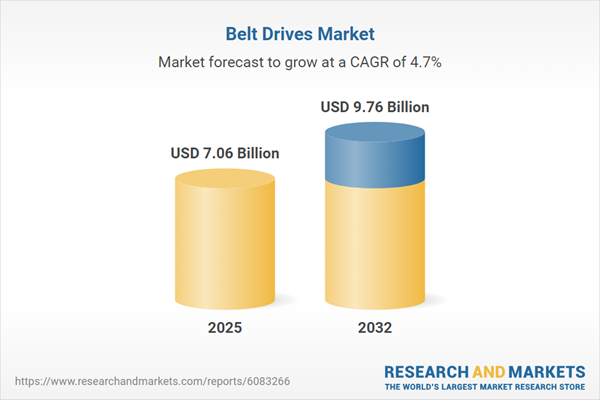Speak directly to the analyst to clarify any post sales queries you may have.
Belt drive technologies remain fundamental to modern industrial systems, powering critical applications across varied sectors. Senior leaders seeking proven means to enhance mechanical power transmission can rely on advanced belt drive solutions to effectively balance durability, efficiency, and cost in both established and emerging operational contexts.
Market Snapshot: Belt Drives Market Growth and Dynamics
The Belt Drives Market grew from USD 6.74 billion in 2024 to USD 7.06 billion in 2025 and is anticipated to expand at a CAGR of 4.73%, reaching USD 9.76 billion by 2032. This trajectory demonstrates strong demand as industries prioritize reliable, scalable power transmission. Ongoing investments in smart manufacturing, digitization, and next-generation materials are reshaping supplier strategies and sustaining marketplace competitiveness. Regional opportunities are emerging across the Americas, EMEA, and Asia-Pacific, further supported by regulatory developments and shifting supply chain priorities.
Scope & Segmentation of the Belt Drives Market
This report covers a comprehensive range of segmentation factors, ensuring actionable insights for procurement, engineering, and investment decision-makers.
- Product Type: Angle Belts (cogged, flat), Flat Belts (fabric, leather, rubber), Timing Belts (fiberglass reinforced, nylon, steel reinforced), V Belts (classical, narrow, synchronous)
- End Use Industry: Agriculture (farm equipment, irrigation systems), Automotive (commercial, electric, passenger vehicles), Construction (heavy machinery, HVAC systems), Industrial Manufacturing (food and beverage, material handling, packaging, textiles), Mining (coal, mineral)
- Drive Type: Enclosed belt drives (belt conveyors, palletizers), Open belt drives (rack and pinion assist, standard open)
- Material: Leather (chrome tanned, vegetable tanned), Metal (steel, titanium), Neoprene (nitrile, polychloroprene), Polyurethane (polyester cords, steel cords), Rubber (EPDM, SBR)
- Power Rating: Heavy duty, light duty, medium duty (20–50 kilowatt, 5–20 kilowatt)
- Geographic Coverage: Americas (US, Canada, Mexico, Brazil, Argentina, Chile, Colombia, Peru), Europe, Middle East & Africa (UK, Germany, France, Russia, Italy, Spain, Netherlands, Sweden, Poland, Switzerland, UAE, Saudi Arabia, Qatar, Turkey, Israel, South Africa, Nigeria, Egypt, Kenya), Asia-Pacific (China, India, Japan, Australia, South Korea, Indonesia, Thailand, Malaysia, Singapore, Taiwan)
- Main Companies Profiled: The Gates Corporation, Continental AG, Mitsuboshi Belting Ltd., Bando Chemical Industries, Optibelt GmbH, Habasit Holding AG, Fenner PLC, Nitta Corporation, Bridgestone Corporation, Carlisle Companies, Inc.
Key Takeaways for Leadership
- Material advancements, such as reinforced polymers and eco-friendly compounds, are driving industry adaptation to operating in challenging environments and meeting sustainability mandates.
- Smart monitoring integration with IoT sensors supports predictive maintenance, helping organizations reduce downtime and extend belt lifecycle.
- Growing regional compliance requirements, especially in EMEA, are influencing belt drive design—demanding quieter operation and environmentally responsible materials.
- Customization in response to evolving end-user needs is fueling investments in modular manufacturing and strategic partnerships for agile production.
- Expansion of belt drive adoption in Asia-Pacific and the Americas is linked to increased industrial automation, mining, and agricultural modernization.
- Component suppliers investing in next-generation fibers and polymers are central to product innovation and premium supplier positioning.
Assessing Tariff Impact on Belt Drives Supply Chain
The 2025 introduction of new United States tariffs on imported industrial components is influencing global supply chain strategies and cost structures. Manufacturers are reviewing regional sourcing, increasing nearshoring to minimize tariff exposure, and forging new supplier agreements to ensure resilient, cost-effective supply lines. Precision belt segments relying on specialized materials face stronger cost pressures, prompting a reassessment of inventory and production models across the value chain.
Methodology & Data Sources
This analysis blends primary and secondary research. Direct interviews with executives and engineers from manufacturing, distribution, and end-user organizations provided first-hand qualitative and quantitative data. Complementary secondary research incorporated industry journals, white papers, regulatory filings, and patent reviews, with rigorous data triangulation and validation by expert panels.
Why This Report Matters for Senior Decision-Makers
- Enables leaders to benchmark against industry best practices in technology, sourcing, and compliance.
- Delivers granular insights to guide investment decisions, R&D focus, and risk mitigation under evolving regulatory and trade conditions.
- Supports the development of strategic alliances by mapping the key players, supply chain trends, and competitive innovation within belt drive markets.
Conclusion
Leaders equipped with this report will be prepared to anticipate market changes, optimize supply chain strategies, and drive growth in the advancing belt drives market. Strategic foresight and operational agility remain critical for sustainable competitive advantage.
Table of Contents
3. Executive Summary
4. Market Overview
7. Cumulative Impact of Artificial Intelligence 2025
Companies Mentioned
The companies profiled in this Belt Drives market report include:- The Gates Corporation
- Continental AG
- Mitsuboshi Belting Ltd.
- Bando Chemical Industries, Ltd.
- Optibelt GmbH
- Habasit Holding AG
- Fenner PLC
- Nitta Corporation
- Bridgestone Corporation
- Carlisle Companies, Inc.
Table Information
| Report Attribute | Details |
|---|---|
| No. of Pages | 199 |
| Published | October 2025 |
| Forecast Period | 2025 - 2032 |
| Estimated Market Value ( USD | $ 7.06 Billion |
| Forecasted Market Value ( USD | $ 9.76 Billion |
| Compound Annual Growth Rate | 4.7% |
| Regions Covered | Global |
| No. of Companies Mentioned | 11 |









